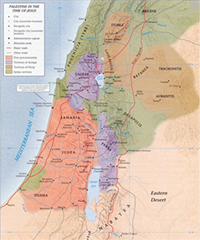
The Holy Land is relatively small, measuring about the size of the state of New Jersey. The northern area, with the Sea of Galilee and the Jordan River at its eastern border, is called Galilee, and this was Jesus’ home for most of his life. The central portion is Samaria, and the southern section is known as Judea. The capital of Judea, Jerusalem, was the center of Jewish religious practice in Jesus’ time and was the place where Jesus was put to death.

During the time of Jesus, Palestine was home to large numbers of gentiles, particularly along the Mediterranean coast and in the North of Galilee, ("Upper Galilee," and "Galilee of the Gentiles"). The principal Jewish areas of Palestine were surrounded by Gentile territories (i.e., Caesarea, Dora, and Ptolemais on the Mediterranean coast; Caesarea Philippi north of Galilee; and Hippus and Gadara east of Galilee). There also were two inland Gentile cities on the west side of the Jordan River near Galilee (Scythopolis and Sebaste). ( Palestine)
The proximity of Gentile and Jewish areas meant that there was some interchange between them, including trade, which explains why Antipas had telōnēs—often translated as “tax collectors” but more accurately rendered as “customs officers”—in the villages on his side of the Sea of Galilee. Jewish merchants and traders could probably speak some Greek, but the primary language of Palestinian Jews was Aramaic. Jews resisted paganism and excluded temples for the worship of the gods of Greece and Rome from their cities. Because Jewish-Gentile relations in the land that the Jews considered their own were often uneasy, Jewish areas were usually governed separately from Gentile areas.
Judaism, as the Jewish religion came to be known in the 1st century AD, was based on ancient Israelite religion with the addition of important features from Babylonia and Persia. The Jews differed from other people in the ancient world because they believed that there was only one God. Like other people, they worshiped their God with animal sacrifices offered at a temple, but, unlike others, they had only one temple, which was in Jerusalem. The Jews believed that they had been specially chosen by God to serve him, obey his laws and be set apart. They believed God called on them to be a "light to the Gentiles" and lead them to accept the God of Israel as the only God.
An important part of Jewish Scripture was the Torah, or Pentateuch, comprising five books (Genesis, Exodus, Leviticus, Numbers, and Deuteronomy) that were believed to have been given to Moses by God. For Jews, those books contain God’s law that covers many aspects of life, requiring that males be circumcised, regulating diet, mandating days of rest for humans and animals and requiring pilgrimage and sacrifice. It provides both rules for the treatment of other people: for example, calling for the use of honest weights and measures in trade and for “love” of both fellow Jews and foreigners.
The laws governing worship (sacrifice, purification, etc.), were similar to the religious laws of other people, but was different because it regulated not only worship but also daily life and made every aspect of life a matter of divine concern. In Jewish Palestine there were three small but important religious parties that differed from each other in several ways: the Pharisees (numbering about 6,000 at the time of Herod), Essenes (about 4,000), and Sadducees (“a few men,” according to Flavius Josephus, in The Antiquities of the Jews 18.17).
The Pharisees were a largely lay group that were the most-precise interpreters of the law and believed in the resurrection of the dead. They also relied on the non-biblical “traditions of the fathers,” some of which made the law stricter. The Essenes were a more-radical sect, with extremely strict rules. ( One segment of the group lived at Qumran along the Dead Sea and produced the Dead Sea Scrolls.) Many aristocratic priests, as well as some prominent laymen, were Sadducees. They rejected the Pharisaic “traditions of the fathers” and denied resurrection of the dead.
Most Jews based their faith and practice on the five books of Moses and rejected the extreme positions of the three parties. To the degree that any of these parties had power, however, it belonged to the Sadducees, the aristocratic priests who had power and authority in Jerusalem. According to the Acts of the Apostles (5:17), those who were around the high priest Caiaphas were Sadducees.
Luke’s infancy narrative affirms that Jesus had a traditional Jewish upbringing. He was circumcised and named on the eighth day after his birth. Forty days later he was "presented" at the Jerusalem Temple in keeping with the Jewish Law. At the age of 12 he made a Passover pilgrimage to the Temple with his parents and John’s Gospel relates other pilgrimages as an adult, (including the final pilgrimage that led to his death).
Jesus' participation in synagogue worship in Nazareth is clear from several Gospel accounts. Mark, Matthew and Luke portray him as reading the Scriptures in public and teaching there. The fact that the people of his hometown rejected him serves as an embarrassing guarantee of the event’s historicity.
It can be said with some confidence that Jesus lived as an observant Jew. He objected to the traditions attached to the Law rather than the Law itself. It can also be said that his relationship to various Jewish groups was closest with the Pharisees who shared interest in topics such as resurrection, Sabbath observance and the relative importance of ritual purity. It is also beyond doubt that Jesus had connection with the movement begun by John the Baptist.
In Jesus’ day, Palestine was part of the Roman Empire. In the East, territories were governed either by kings who were "friends and allies" of Rome (often called "client" kings) or by governors supported by a Roman army. When Jesus was born, all of Jewish Palestine—as well as some of the neighboring Gentile areas—was ruled by Rome’s able "friend and ally," Herod the Great. ( Herod's Kingdom)
For Rome, Palestine was important because it lay between Syria and Egypt, two of Rome’s most valuable possessions. Rome had legions in both countries but not in Palestine. Roman policy required that Palestine be loyal and peaceful so that it did not undermine Rome’s larger interests. That end was achieved for a long time by permitting Herod to remain king of Judea (37–4 BC) and giving him a free hand in governing his kingdom.
When Herod died shortly after Jesus’ birth, his kingdom was divided into five parts. Most of the Gentile areas were separated from the Jewish areas, which were split between two of Herod’s sons, Herod Archelaus, who received Judea, Idumaea and Samaria, (which was non-Jewish), and Herod Antipas, who received Galilee and Peraea. (In the New Testament, Antipas is somewhat confusingly called Herod, because the sons of Herod took his name). Both sons were given lesser titles than king: Archelaus was ethnarch, and Antipas was tetrarch. The non-Jewish areas (except Samaria) were assigned to a third son, Philip, to Herod’s sister Salome, or to the province of Syria. ( Divided Kingdom)
Emperor Augustus deposed the unsatisfactory Archelaus in AD 6, and transformed Judea, Idumaea, and Samaria from a client kingdom into an imperial province to which he assigned a Roman prefect for governance. That minor Roman aristocrat (later called a procurator) was supported by a small Roman army of approximately 3,000 men. The soldiers, however, came not from Italy but from nearby Gentile cities. During Jesus’ public career, the Roman prefect was Pontius Pilate (ruled AD 26–36).
Although nominally in charge of Judea, Samaria, and Idumaea, the prefect did not govern his area directly. Instead, he relied on local leaders. The prefect and his small army lived in the predominantly Gentile city Caesarea Maritima, on the Mediterranean coast. They came to Jerusalem only to ensure peace during the pilgrimage festivals when large crowds and patriotic themes sometimes combined to spark unrest or uprisings.
On a day-to-day basis Jerusalem was governed by the high priest. Assisted by a council, he had the task of mediating between the remote Roman prefect and the local populace, which was hostile toward pagans and wanted to be free of foreign interference. His political responsibility was to maintain order and to see that tribute was paid. Caiaphas, the high priest during Jesus’ adulthood, held the office from about AD 18 to 36. Since he and Pilate were in power together for 10 years, they likely collaborated successfully.
Most people in the ancient world produced food, clothing, or both and could not afford luxuries. Most Palestinian Jewish farmers and herdsmen did earn enough to support their families and offer sacrifices during annual festivals. Most could also let their land lie fallow in the sabbatical years when cultivation was prohibited.
Galilee was relatively prosperous, since the land and climate permitted abundant harvests and supported many sheep. Archaeological remains from the 3rd, 4th, and 5th centuries confirm the plausibility of 1st-century references to the region’s prosperity. There were, of course, landless people, but the Herodian dynasty made sure to organize large public works projects that employed thousands of men.
Deep poverty was also present. Few if any Palestinian Jews had the vast fortunes that successful merchants in port cities could accumulate. However, there were Jewish aristocrats with large estates and the merchants who served the Temple (supplying incense and fabric, etc.) could become very prosperous.

Travel in Jesus' time was limited, and almost exclusively by foot or donkey.
Some of Jesus’ journeys were around the Sea of Galilee, along the River Jordan, to Jericho and Jerusalem in the highlands and deserts. The weather, availability of food and safety of the roads would have impacted the journeys considerably. Both male and female friends of Jesus gave him shelter and food at various times on his travels.
Journeys
John the Baptist Beyond Galilee Galilee to Judea Jerusalem Passion Week
| Jerusalem to Bethlehem | 10 km | 2-3 hours |
| Jerusalem to the Dead Sea | 10 km | 2-3 hours |
| Jerusalem to Jericho | 24 km | 6 hours |
| Jerusalem to the Jordan River | 34 km | 8 hours |
| Jerusalem to Nazareth | 104 km | 3 days |
| Jerusalem to Lake Galilee | 112 km | 3 1/2 days |
